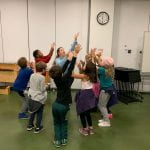Essential Questions:
- How can I best represent a culture that is not my own?
- What makes an experience authentic?
- How can I, as a white teacher, best support students of color while exploring culture and heritage?
Reflective Practice
I decided on this particular unit as it supported a part of the third grade social studies curriculum. In learning about New Amsterdam the students study the background and places of the Dutch (Holland), the Lenape (New York) and the Africans (Africa) between the 1500-1600’s. In their classroom, the “Mystery Time and Place” activity is designed to aid students in building context around what was going on in the world at this time, specifically, to show how Africans lived and what was important to them.
I wanted to connect students to West Africa’s rich culture of music and dance and to create a meaningful experience intended to assist them in building empathy, respect, understanding and connection to the people at the time. A challenge I faced was how to accurately represent this culture when my background is that of a white woman schooled in western classical music. I decided that bringing in someone who specialized in West African Dance supported a more authentic experience for the students.
Students were given artifacts, such as maps and pictures to uncover that the mystery time and place was Africa. When showing up to the workshop they did not know what to expect other than that it was related to Africa. The students were excited and engaged from the moment they stepped into the room. I took a secondary role and played the djembe drum (a traditional West African instrument) while Shaahida, our expert dance teacher, introduced Sinte, a popular dance, originally from the Nalu people of Guinea.
 After the workshop we debriefed and the students and teachers discussed how the movements of the dance depicted the day to day life of African people. The students spoke about the materials that were available at the time, such as wood with animal skin for the drums and shells for shakers. I was impressed with the knowledge they brought to this conversation.
After the workshop we debriefed and the students and teachers discussed how the movements of the dance depicted the day to day life of African people. The students spoke about the materials that were available at the time, such as wood with animal skin for the drums and shells for shakers. I was impressed with the knowledge they brought to this conversation.
Continuing the work is an important next step for me. We have already begun learning songs and games from West African culture and some of the third grade students will share the dance at their music share this month. This learning experience would be further enhanced if the students were given the opportunity to observe Sinte performed prior to beginning the workshop. This is something I will work on for future years.
This opportunity would not have been as successful without the preparation that happened in the classroom beforehand. The third graders came with an openness to learn, they were respectful and thoughtful. It confirms my thought that once-off projects are not enough when learning about cultures and that continual engagement through many different lenses and canvases is important.
Learning this dance from Shaahida, a dancer who specializes in the dances of the African Diaspora, made this feel like a more authentic experience to me. While accompanying the dancers on the djembe and taking on the role of an observer, I saw students make connections with the movements, with each other and with Shaahida who presents as a woman of color.
 Taking this step back gave me some perspective; where possible, it is important to go deeper, to do better, to bring forward the most accurate representation of culture and heritage when the resources are available. In my role as a music teacher, and as someone who works continuously on anti-bias approaches to my work with students, it is my responsibility to do so in a way that does not appropriate someone else’s heritage. Sometimes I am the only link between a child and a particular culture through the music program and I am continuing to reflect on how best to represent a culture that is not my own.
Taking this step back gave me some perspective; where possible, it is important to go deeper, to do better, to bring forward the most accurate representation of culture and heritage when the resources are available. In my role as a music teacher, and as someone who works continuously on anti-bias approaches to my work with students, it is my responsibility to do so in a way that does not appropriate someone else’s heritage. Sometimes I am the only link between a child and a particular culture through the music program and I am continuing to reflect on how best to represent a culture that is not my own.


Aedin, thanks for engaging in this work. I think that one of the powerful things you are modeling here is how as white educators we can find moments to step to the side and welcome in other voices, experiences and expertise. My guess is that you could have “taught” this workshop, but it would have been a different workshop in terms of how it was experienced by learners. While it is probably not always possible to do this, I wonder if we always spend the necessary time at least surfacing this complexity with students. In doing so, we are at least modeling for them an awareness of and respect for the diverse experiences in the room.